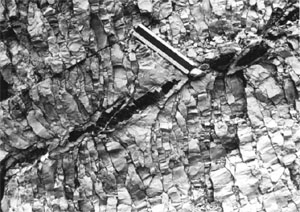| |||||||||
|
|
|||||||||
|
|
|||||||||
| Strain of Pressure Solution Seams | |||||||||
|
The total amount of material removed by pressure solution may be large. In closed systems, from which solution cannot escape, the shortening quickly reaches 4% to 6% and remains constant due to restriction of dissolution in such systems. In open systems, the shortening is linearly proportional to the degree of the pressure solution and thus the depth of burial (Hortenbach, 1977) without such restriction. For example, Safaricz and Davison (2005) estimated vertical shortening of 50% and 60% in chalk at Flamborough Head and Machar oil field, United Kingdom Central Graben, the North Sea. There exist various methods to calculate the shortening due to pressure solution. The first one is a direct method: By comparing the present length of the beds with pressure solution and the total length of a nearby insoluble horizons in Scaglia Rossa pelagic limestone with extensive chert layers in the Apennines, Italy, Alvarez et al. (1976) estimated the tectonic shortening due to pressure solution in the limestone to be about 30%. Figure 1 is an outcrop photo showing shortening parallel to bedding due to pressure solution in the limestone layers and the deformation of the chert layers (dark) by faulting and folding. A similarly large amount of shortening has been estimated by Dunnington (1967) using bed-parallel stylolites from three oilfields in the Middle East. Another method is chemical comparison of pressure solution residue with uneffected rocks. This method is based on the principle of differential mineral solubility and element mobility (Trurnit, 1968). Insoluble material passively concentrates in the zone of depletion of mobile elements of soluble minerals. The element enrichment in the residue relative to adjacent rock can then be used to calculate the dissolved volume based on two assumptions: rock between pressure-solution seams is representative of the bulk composition of dissolved rock; and concentrations of elements in the rock and residue have not been changed by any process other than pressure solution. Elements with middle ion potential (Al, Ti, and Fe) form insoluble hydrolysates during hydration, are relatively immobile and will passively concentrate in the residue. The concentration of an element or its oxide in the residue divided by its concentration in the unaffected rock is termed the enrichment ratio, R(enr). The volume loss is calculated as shown in Equation 1, where th(res) is residue thickness and th(p) is the preserved thickness of the section.
The third method is stylolite amplitude method based on the assumption that a stylolite begins as a planar surface, and that the amplitude of the suturing increases as more material is removed. The double amplitude (peak to trough) of a stylolite should then equal to the thickness of the dissolved rock (Stockdale 1922). This method provides a minimal estimate of the material removed because components of solution seams could be equal on both sides, so that no relief is produced, or stylolite amplitude decreases when the two of them merge. To account this factor, Safaricz and Davison (2005) improved this method by combining residue thickness and double-amplitude measurement, assuming in a homogeneous rock, the same amount of dissolution will lead to the same residue thickness with similar composition. If the amount of dissolved components and the amount of residue are known for a certain seam, the amount of dissolution of other seams with varying residue thickness can be determined. Large number of stylolites should be examined to find the largest double-amplitude to residue thickness ratio expected to occur in single stylolites that are not merged. The volume loss can be estimated by Equation 2. Safaricz and Davison showed that the improved stylolite amplitude method agreed well with the chemical comparison method on estimating the shortening of North Sea chalk with large degree of pressure solution mentioned earlier.
| |||||||||
| Reference: |
|||||||||
| Alvarez, W. , Engelder, T., Lowrie, W., 1976 Dunnington, H.V., 1967 Hortenbach, R., 1977 Safaricz, M., Davison, I., 2005 Stockdale, P.B., 1922 |
|||||||||
|
Readme | About Us | Acknowledgement | How to Cite | Terms of Use | Ⓒ Rock Fracture Knowledgebase |
|||||||||
